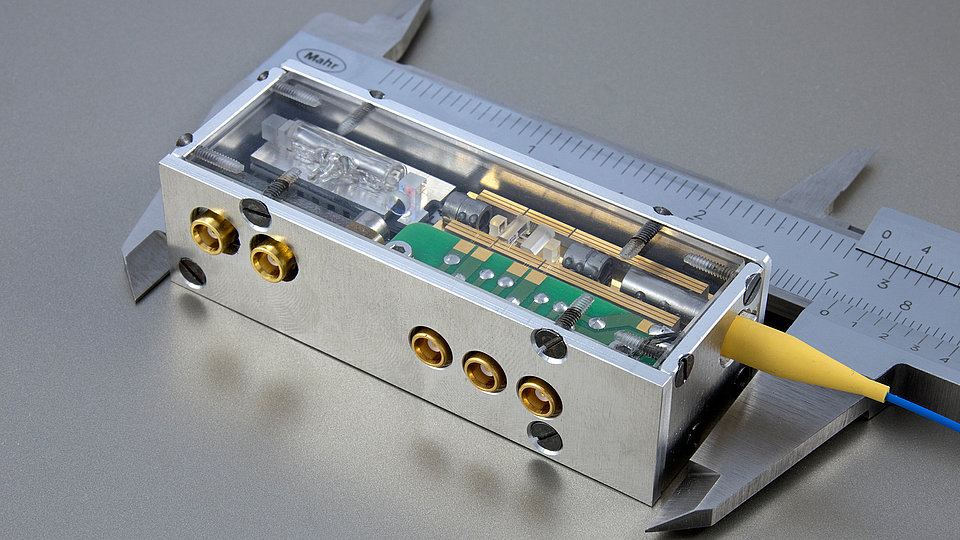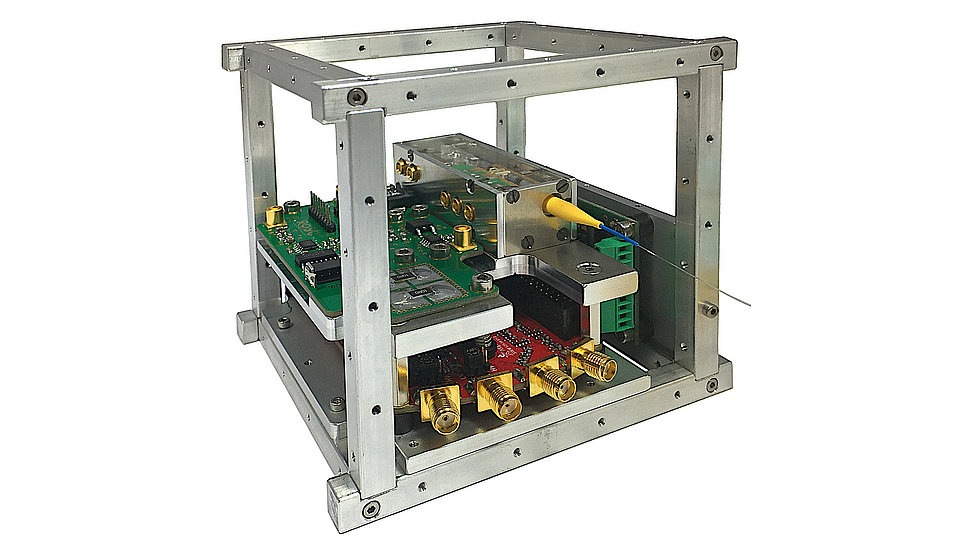Enabling quantum technologies on nanosatellites – micro-integrated optical frequency reference based on rubidium vapor
Optical frequency references (OFR) are among the key components of optical clocks, length metrology systems and atomic quantum sensors. Operated in space, these technologies promise major improvements in next-generation satellite-based navigation, ranging, and earth observation, respectively.
As a platform for these applications, small satellites have recently gained attention in and outside the space community. Reduction in cost and the possibility to realize short mission development times make this satellite class predestined for in-orbit demonstration of enabling technologies. Still, miniaturization of the devices is necessary and particularly challenging, as small satellites only offer a few liters of volume for the payloads.
In the IQSoC project (“Integrated Quantum Sensors on CubeSats”), a CubeSat-compatible OFR module was developed [1]. The module shown in Fig. 1 has a volume of 70 × 26 × 19 mm³ and a relative frequency instability of 1.7 x 10-12 at 1 second averaging time and reaches 3.4 x 10-13 at 100 seconds averaging time. This makes it one of the most compact realizations of an optical frequency reference at this level of performance. Light from a distributed feedback (DFB) diode laser with a wavelength of 780 nm is used for spectroscopy of rubidium vapor contained inside a glass cell. The Doppler-free absorption features of rubidium's D2-transition serve as the feedback signal to stabilize the laser's frequency. Laser and spectroscopy unit are typically modularized and separated in such systems [2,3], which enables independent development but comes with higher volume because of the necessary interfaces. With this module, a DFB diode laser, a rubidium vapor cell and detectors are integrated into one temperature-controlled and fiber-coupled package. To operate the module, a compact low-noise current driver and software for an FPGA-based control system were developed [4]. Together with a commercial temperature controller, a complete demonstrator fitting into a 1 U CubeSat frame could be assembled, shown in Fig. 2.
This work was carried out in a collaboration between Humboldt-Universität zu Berlin and National University of Singapore, supported by the Berlin University Alliance. The micro-integration was realized at FBH. It was also supported by the German Space Agency DLR with funds provided by the Federal Ministry for Economic Affairs and Energy (BMWi) under grant numbers 50RK1971 (ROSC), 50WM2066 (OPTIMAL-QT) and 50RK1978 (QCHIP).
Publications
[1] A. Strangfeld, S. Kanthak, M. Schiemangk, B. Wiegand, A. Wicht, A. Ling, M. Krutzik, “A Prototype of a Compact Rubidium-Based Optical Frequency Reference for Operation on Nanosatellites” J. Opt. Soc. Am. B 38, 1885-1891 (2021).
[2] V. Schkolnik, O. Hellmig, A. Wenzlawski, J. Grosse, A. Kohfeldt, K. Döringshoff, A. Wicht, P. Windpassinger, K. Sengstock, C. Braxmaier, M. Krutzik, A. Peters, „A compact and robust diode laser system for atom interferometry on a sounding rocket” Appl. Phys. B 122, 217 (2016).
[3] Frye, K., Abend, S., Bartosch, W. et al.The Bose-Einstein Condensate and Cold Atom Laboratory” EPJ Quantum Technol. 8, 1 (2021).
[4] B. Wiegand, “Linien”, GitHub, https://github.com/hermitdemschoenenleben/linien (2020).

